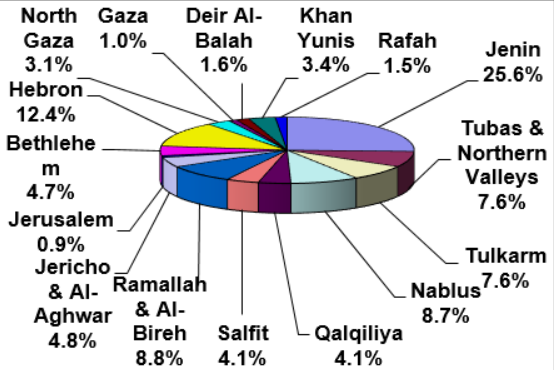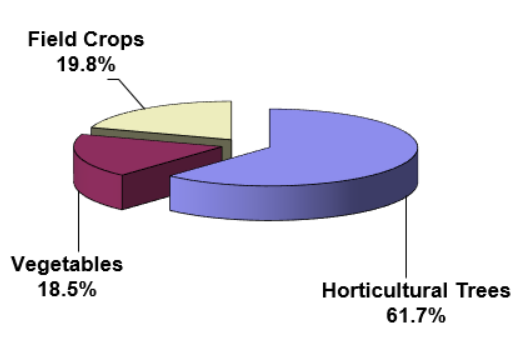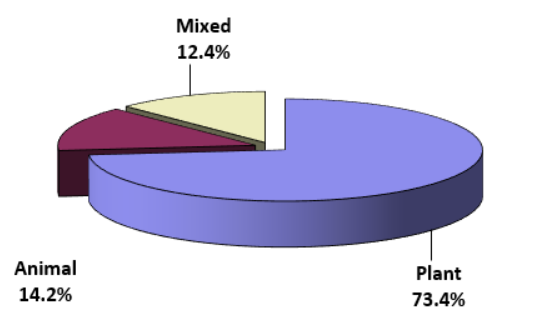Palestinian Central Bureau of Statistics (PCBS) and the Ministry of Agriculture (MoA) Issue a Joint Press Release on the Preliminary Results of Agriculture Census, 2021
The Palestinian Central Bureau of Statistics (PCBS) and Ministry of Agriculture (MoA) announce the preliminary results of the Agriculture Census, 2021 in the State of Palestine today Thursday 16/06/2022.
H.E. Dr. Ola Awad, President of the Palestinian Central Bureau of Statistics/National Director of the Agriculture Census, 2021, considered that the implementation of second Agriculture Census, 2021 is a major statistical project at the national level. Hence, its implementation is a legal, developmental and statistical entitlement. This Agriculture Census is particularly important due to its link to the land which is an expression of the Palestinian national sovereignty. H.E. Dr. Awad also added that the Agriculture Census is the second one of its kind to be implemented in the State of Palestine, in close cooperation and partnership between PCBS and MoA.
H.E. Dr. Awad, indicated that the Agriculture Census, 2021 data will contribute to drawing a clear picture of the reality of agricultural sector in Palestine which will help decision-makers to make evidence based decisions, plans and policies to develop the agricultural sector. It also facilitates the building of an Agricultural Statistical Register, which will be established and updated in cooperation with MoA.
Moreover, H.E. Dr. Awad noted that the Agriculture Census data are an information treasure on Palestine, which reflects in numbers the reality of the Palestinian agricultural sector, covering both plant and livestock sectors. Such information will be available to all segments of users, and by all available means. H.E. Dr. Awad also called everyone to benefit from these figures and invest them, by reflecting them into plans, programs and interventions. This all shall contribute to achieving the vision of the Palestinian government, entitled "Citizen First".
H.E. Dr. Awad wishes to extend her gratitude and appreciation to the political leadership, represented by H.E. President Mahmoud Abbas “Abu Mazen”, and to the Palestinian Government, represented by H.E. Dr. Mohammad Shtayyeh, the Prime Minister, for their support, and interest in implementing this national project. Gratitude and appreciation is also extended to our Palestinian people for their awareness, cooperation with the census team, and to all colleagues from PCBS and colleagues from MoA for their exceptional efforts, dedication and hard work, as well as to the main donors of the census, , international institutions and organizations, for their contribution and technical and financial support to the project, in addition to all ministries, public and private institutions, security forces, civil society institutions, universities, local authorities, and official and private media for their contribution and support, as well as to tribal chiefs, and influencers in the society, for their role in overcoming the obstacles that faced the census team, and to everyone who contributed to the success of this national vital project.
H.E. Mr. Riyad Attari, Minister of Agriculture, indicated that within the framework of the continuous efforts made by the Ministry of Agriculture to provide an integrated database on the reality of the Palestinian agricultural sector, the second Agriculture Census project, 2021 has been implemented in cooperation and partnership between MoA and PCBS. Also. H.E. Mr. Attari pointed out that this achievement is within the Palestinian achievements that embody sovereignty and national identity in the face of the arbitrary measures of the occupation against the Palestinian agricultural sector.
H.E. Mr. Attari expressed his deep appreciation and gratitude for the exceptional efforts made by PCBS through the continued support and follow-up of H.E. Dr. Ola Awad, President of PCBS, affirming the consideration of this Agriculture Census in Palestine as a legal, developmental and national entitlement, in addition to being a statistical entitlement that multiple sectors and institutions shall benefit from and will help setting real developmental plans and policies.
H.E. Mr. Attari praised all the technical and administrative teams that carried out this census with a high level of dedication, efficiency and effectiveness, and called for continued cooperation and partnership with PCBS in conducting new projects that serve the Palestinian agricultural sector in both the agricultural and livestock fields, which face great challenges. This census helps MoA and the relevant authorities in raising the efficiency of government plans and policies, and provides sufficient data and information regarding the agricultural sector about the various alternatives and options available to MoA, and improves management, monitoring and evaluation processes for projects and institutions operating in the Palestinian agricultural sector.
Also, H.E. Mr. Attari confirmed that the Agriculture Census strongly highlights the contribution of the Palestinian Agricultural sector in the sustainable agricultural development in Palestine, due to its significant importance in identifying the number of agricultural holdings (plants and animal), that, in return, reflects the importance of the agriculture census as a cornerstone and key pillar necessary for the Palestinian national income
The following are the most important results of the Agriculture Census, 2021
94% of the total area of agricultural holdings are cultivated area
As of 01/10/2021, the total area of agricultural holdings reached 1.21 million dunums, of which 1.14 million dunums are lands cultivated with permanent crops (horticulture trees), temporary crops (vegetables and field crops), lands under temporary meadows and pastures, land under temporarily fallow, and land under permanent meadows and pastures with 94.2% of the total area of agricultural holdings. Whereas, the uncultivated area of lands reached 70,671 dunums, including buildings used for agriculture holding purposes, forests and wooded land, and other areas such as: parks, open spaces, and passages) in addition of 82 dunums of the areas were used for aquaculture.
19% of the total area of Palestine are cultivated area
The percentage of cultivated area out of the total area in Palestine reached 18.9 % (18.5% in the West Bank and 24.6% in Gaza Strip). Moreover, the highest percentage of cultivated area out of the total area by governorate was in Jenin Governorate with a percentage of 49.4%, followed by Qalqiliya Governorate with a percentage of 35.1%, and North Gaza Governorate and Tulkarm Governorate with a percentage of 34.4% and 34.0%, respectively
26% of Cultivated Area of Horticulture Trees, Vegetables and Field Crops are in Jenin Governorate.
The total cultivated area in Palestine during the agricultural year of 2020/2021 reached 1,096.3 thousand dunums (89.4% in the West Bank and 10.6% in Gaza Strip), compared to 911.6 thousand dunums in 2010, with an increase of 184.7 dunums. At the level of governorates, the highest percentage of cultivated areas during 2021 was in Jenin Governorate with a percentage of 25.6%, while the lowest percentage of cultivated area was in Jerusalem with a percentage of 0.9% (10.3 thousand dunums).
Percentage Distribution of Cultivated Area in Palestine by Governorate, 2020/2021

85% of the total area cultivated with horticultural trees are cultivated with olive trees
The total area cultivated with horticultural trees reached 676.8 thousand dunums in the agricultural year 2020/2021 (94.7% in the West Bank and 5.3% in Gaza Strip), compared to 542.4 thousand dunums in the agricultural year 2009/2010, with an increase of 134.4 thousand dunums. The percentage of areas cultivated with horticultural trees reached 61.7% of the total area cultivated with crops in the agricultural year 2020/2021. The area cultivated with olive trees represents the largest share of horticultural trees in Palestine, covering 575.2 thousand dunums (85.0% of the total area of horticultural trees), followed by grapes (29.1 thousand dunums, i.e. 4.3% of the total area of horticultural trees in 2020/2021).
The highest cultivated area with olives was in Jenin Governorate with an area of 152 thousand dunums. The highest cultivated area with dates and bananas was in Jericho & Al-Aghwar Governorate with an area of 27.2 thousand dunums and 755 Dunums, respectively. The highest cultivated area planted with grapes was in Hebron and Bethlehem Governorates with an area of 12.4 and 8.9 thousand dunums respectively. Also, there are 464 and 389 dunums figs in Ramallah and Al-Bireh and Nablus Governorates, respectively. Also, Qalqiliya Governorate is known by guava and avocado crops, where the cultivated area of these crops reached 2,507 and 1,072 dunums, respectively. Finally, Gaza Strip is known by citrus trees, where 7,550 dunums are cultivated with citrus trees.
12% of the total area cultivated with vegetables are cultivated with potato crops
The cultivated area with vegetable crops reached 202.3 thousand dunums during the agricultural year 2020/2021(69.6% in the West Bank and 30.4% in Gaza Strip), compared with 127.3 thousand dunums during the agricultural year 2009/2010, with an increase of 75 thousand dunums. The cultivated area with vegetable crops represented 18.5% of the total cultivated area with vegetable crops in the agricultural year 2021. By type of crops: potatoes were the most cultivated crops with 23.5 thousand dunums (11.6% of the total cultivated area with vegetable), followed by cucumbers with 21.5 thousand dunums (10.6% of the total cultivated area with vegetable) during the agricultural year 2020/2021.
The highest cultivated area with cucumbers was in Jenin Governorate with an area of 6,360 dunums, while the highest cultivated area with potato crops was in Tubas & Northern Valleys Governorate with an area of 7,625 dunums. Also, Gaza Strip was the highest cultivated area with tomato and strawberry crops with an area of 6,997 and 4,301 dunums, respectively.
47% of the total area cultivated with field crops are cultivated with wheat
The cultivated area with field crops in Palestine reached 217.2 thousand dunums in the agricultural year 2020/2021(91.2% in the West Bank and 8.8% in Gaza Strip), compared with 241.9 thousand dunums in the agricultural year 2009/2010, with a drop of 24.7 thousand dunums. The cultivated areas with field crops reached 19.8% of the total cultivated areas with field crops in Palestine during the agricultural year 2021. By type of crops: wheat ranked the highest among field corps with 101 thousand dunums (46.5% of the total area cultivated with field crops in Palestine), followed by barley with 49.5 thousand dunums (22.8% of the total area cultivated with field crops in Palestine), in the agricultural year 2020/2021.
Percentage distribution of cultivated area in Palestine by type of crops, 2020/2021

About 30% of cattle in Palestine are raised in Hebron Governorate
On 01/10/2021, the number of cattle in Palestine reached 67,760 heads (78.5% in the West Bank and 21.5% in Gaza Strip), compared to 33,925 heads on 01/10/2010. This number increased by 33,835 heads. By governorate, Hebron Governorate ranked at the top of governorates in terms of cattle breeding with 20,558 heads (30.3% of the total number of cattle heads in Palestine) during the agricultural year 2020/2021, while Jerusalem ranked the lowest with only 264 heads with 0.4% of the total number of cattle heads in Palestine during the same year.
About 26% of sheep in Palestine are raised in Hebron Governorate
On 01/10/2021, the number of sheep in Palestine reached 771,168 heads (92.5% in the West Bank and 7.5% in Gaza Strip), compared to 567,236 heads on 01/10/2010, with an increase of 203,932 heads. By governorate, Hebron ranked the highest in terms of sheep with 200,245 heads (26.0% of the total number of sheep heads in Palestine), while Rafah ranked the lowest with only 7,256 heads (0.9% of the total number of sheep heads in Palestine during the agricultural year 2020/2021.
About 21% of goats in Palestine are raised in Bethlehem Governorate
On 01/10/2021, the number of goat heads in Palestine reached 239,966 heads (96.4% in the West Bank and 3.6% in Gaza Strip), compared to 219,364 heads on 01/10/2010, with an increase of 20,602 heads. By governorate, Bethlehem ranked the highest in terms of the number of goat with 50,459 heads (21.0% of the total number of goat heads in Palestine), while Rafah ranked the lowest with 616 heads (0.3% of the total number of goat heads in Palestine) in the agricultural year 2020/2021.
About 19% of beehives in Palestine are raised in Jenin Governorate
On 1/10/2021, there were 64,360 beehives in Palestine (74.0% in the West Bank and 26.0% in Gaza Strip), compared to 38,216 beehives on 1/10/2010, with an increase of 26,144 beehives. By governorate, Jenin Governorate ranked the highest in terms of the number of beehives of 12,305 (19.1% of total number of beehives in Palestine), while Jerusalem Governorate ranked the lowest with 378 (0.6% of the total number of beehives in Palestine) during the agricultural year 2020/2021.
About 20% of broilers in Palestine are raised in Jenin Governorate and 29% of layers in Palestine are raised in Hebron Governorate
The number of broilers in the agricultural year 2020/2021 in Palestine reached 71 million birds (80.4% in the West Bank and 19.6% in Gaza Strip) compared to 31.1 million birds in the agricultural year 2009/2010, with an increase of 39.9 million birds. By governorate, Jenin ranked the highest with 14.2 million birds with a percentage of 20.0% of the total number of broiler in Palestine, while Salfit ranked the lowest with 552.1 thousand birds with a percentage of 0.8% of the total number of broiler in Palestine during the agricultural year 2020/2021.
In the agricultural year 2020/2021, the total number of layers in Palestine reached 3.6 million birds (84.5% in the West Bank and 15.5% in Gaza Strip), compared to 1.5 million birds in the agricultural year 2009/2010, with an increase 2.1 million. By governorate, Hebron ranked the highest with 1.1 million birds with a percentage of 29.3% of the total number of layers in Palestine and Tubas & Northern Valleys ranked the lowest with 2.2 thousand birds with a percentage of 0.06% of the total number of layers in Palestine during the agricultural year 2021.
92% of Agricultural holders are males:
The number of agricultural holders reached 137,985 holders during the agricultural year 2020/2021 (82.4% in the West Bank and 17.6% in Gaza Strip), compared to 110,104 holders during the agricultural year 2009/2010, with an increase of 27,881 holders over the past eleven years. The number of agricultural holders in Palestine by sex reached 127,332 males (92.3%) and 10,653 females (7.7%) in the agricultural year 2020/2021.
73% of Agricultural holdings are plant holdings
The number of agricultural holdings in 2020/2021 reached 140,568 (82.4% in the West Bank and 17.6% in Gaza Strip), compared to 111,310 holdings in 2009/2010 (an increase of 29,258 holdings). As for the number of holdings by type of holding, data showed that the most common type of agricultural holding was plant holdings with a number of 103,143 holdings (73.4% of the total number of agricultural holdings in Palestine), while there were 19,909 animal holdings (14.2% of the total number of agricultural holdings in Palestine), whereas 17,516 holdings were mixed holdings (12.4%) during the agricultural year 2020/2021.
Percentage Distribution of Agricultural Holdings in Palestine by Type of Holding, 2020/2021

 عربي
عربي